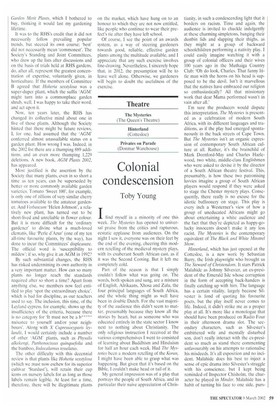Change for change's sake
Ursula Buchan
I their lives, gardeners seek perfection in what they do, endeavouring to create immaculate landscapes populated with ideal plants. In doing so, they know they chase a chimera which can only be captured — and that rarely — in the photographic images in books, where no leaf is pocked by slug hole and no flower is fading. But that knowledge does not stop them trying.
Even a large organisation like the Royal Horticultural Society is not immune to this quest. Ten years ago, it reintroduced the Award of Garden Merit (AGM), which had fallen out of use, as a way of singling out plants of particular garden value. The idea was 'to highlight the best plants available to the ordinary gardener', some 6,557 of them, of every kind from tree to greenhouse climber, from tender annual to hardy vegetable.
The criteria were: a plant must be of 'outstanding excellence' for ordinary garden decoration or use; available from nurseries, seed suppliers or specialist growers; of good constitution; not requiring highly specialist growing conditions or care; not particularly susceptible to pest or disease; not 'reverting' easily, for example, from variegated leaves to plain green ones.
The ordinary gardener discovered these best plants by the cup icon placed next to names of AGM plants in The RI-IS Plant Finder, on coloured labels stuck in pots in garden centres, in nursery catalogues or in the gardening pages of newspapers. These awards, along with useful hardiness ratings, were encapsulated in a book, Award of
Garden Merit Plants, which I bothered to buy, thinking it would last my gardening lifetime.
It was to the RHS's credit that it did not necessarily follow prevailing popular trends, but steered its own course; 'best' did not necessarily mean 'commonest'. The Society's Standing and Joint Committees, who drew up the lists after discussions and on the basis of trials held at RHS gardens, do, after all, represent the greatest concentration of expertise, voluntarily given, in horticulture. If the members of Committee B agreed that Hohetia sexstqosa was a super-duper plant, which the suffix `AGM' might turn into a commonplace garden shrub, well, I was happy to take their word, and act upon it.
Now, ten years later, the RHS has changed its collective mind about one in five of those plants. Although the Society hinted that there might be future reviews, I, for one, had assumed that the 'AGM' conferred almost unassailable status on a garden plant. How wrong I was, Indeed, in the 2002 list there are a thumping 889 additions, and an even more thumping 1,229 deletions. A new book, AGM Plants 2002, has appeared.
Most justified is the assertion by the Society that many plants, even in so short a time as ten years, can be superseded by better or more commonly available garden varieties. Tomato `Sweet 100', for example, is only one of zillions of very similar cherry tomatoes available to the amateur gardener. And Verbascum 'Helen Johnson', a relatively new plant, has turned out to be short-lived and unreliable in flower colour. But it is more difficult for the 'ordinary gardener' to divine what a much-loved clematis, like 'Perle d'Azur' (one of my ten all-time favourite plants, by the way), has done to incur the Committees' displeasure. The official word is `susceptibility to mildew'; if so, why give it an AGM in 1992?
By such substantial changes, the RHS has risked undermining its own authority in a very important matter. How can so many plants no longer reach the standards required after so short a time? Apart from anything else, we members now feel entitled to play `spot the extraordinary choice', which is bad for discipline, as our teachers used to say. The inclusion, this time, of the Leyland cypress, for example, shows up the insufficiency of the criteria, because there is no category for 'It must not be a b"*" nuisance to yourself and/or your neighbours'. Along with X Cupressocyparis leylandii, I would certainly include a number of other 'AGM' plants, such as Physalis alkekengi, Parthenocissus quinquefolia and the bamboo, Indocalamus tesselatus.
The other difficulty with this decennial review is that plants like Hoheria sexstylosa (which we must now eschew for its superior cultivar `Stardust'), will retain their cup icons on nursery labels for as long as those labels remain legible. At least for a time, therefore, there will be illegitimate plants on the market, which have hung on to an honour to which they are not now entitled, like people who continue to wear their prefect's tie after they have left school.
Of course, I see the point of an awards system, as a way of steering gardeners towards good, reliable, effective garden plants among the multitude available, and I appreciate that any such exercise involves line-drawing. Nevertheless, I sincerely hope that. in 2012, the presumption will be to leave well alone. Otherwise, we gardeners will begin to doubt the usefulness of the exercise.















































































 Previous page
Previous page